Continuum and Molecular Modeling of Chemical Vapor Deposition at Nano-Scale Fibrous Substrates
Abstract
:1. Introduction
2. DSMC and Deposition at Rigid Surface
2.1. Development of DSMC and Continuum Models for Gas Flow in Proximity of Rigid Boundary
- 1.
- Particle initialization;
- 2.
- Computational displacement of simulated particles after time interval ;
- 3.
- Indexing and cross referencing of simulated particles as they move between DSMC cells;
- 4.
- Computing of particles’ new velocities after inter-particle collisions and collisions between simulated particles and wall surface;
- 5.
- Sampling simulated DSMC particles to obtain macroscopic properties.
2.2. Validation of DSMC Method and Computer Code
3. Model of Deposition of Carbon Particles at Fibers
3.1. The Reactor Flow Field
3.2. Setup of Fibers
3.3. Effect of Sticking Coefficient on Deposition Rate
3.4. Effect of Distance between the Fibers
3.5. Effect of Rarefaction
4. Conclusions
Author Contributions
Funding
Data Availability Statement
Conflicts of Interest
Appendix A. Convergence Study
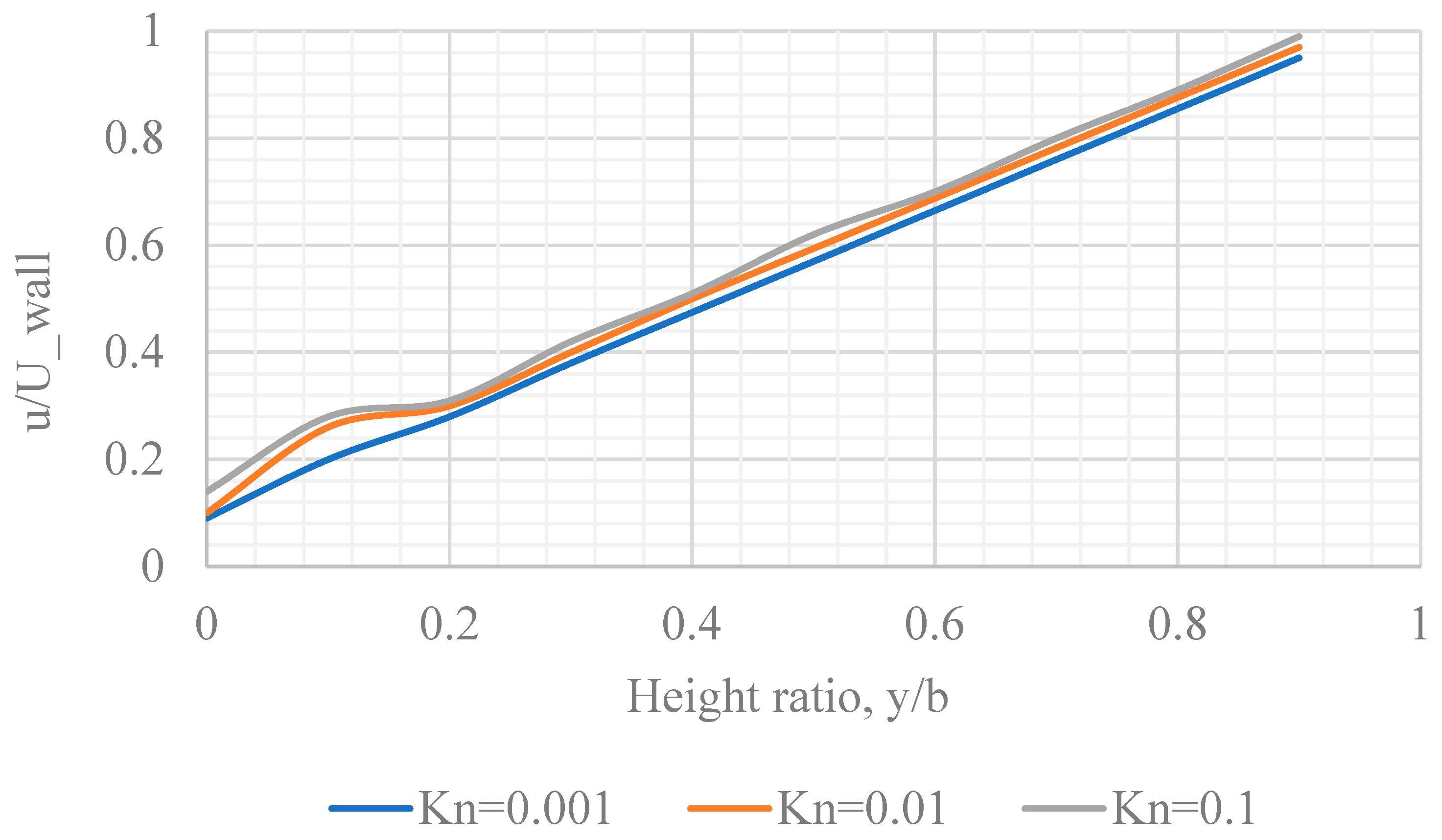
References
- Mittal, M.; Sardar, S.; Jana, A. Nanofabrication Techniques for Semiconductor Chemical Sensors. In Handbook of Nanomaterials for Sensing Applications; Elsevier: Amsterdam, The Netherlands, 2021; pp. 119–137. [Google Scholar]
- “Vapor Deposition”. Available online: https://corrosion-doctors.org/MetalCoatings/VaporDep.htm (accessed on 25 October 2023).
- Bird, G.A. Monte Carlo Simulation of Gas Flows. Annu. Rev. Fluid Mech. 1978, 10, 11–31. [Google Scholar] [CrossRef]
- Barua, H.; Povitsky, A. Numerical Model of Carbon Chemical Vapor Deposition at Internal Surfaces. Vacuum 2020, 175, 109234. [Google Scholar] [CrossRef]
- Kleijn, C.R.; Hoogendoorn, C.J. A study of 2-and 3-D transport phenomena in horizontal chemical vapor deposition reactors. Chem. Eng. Sci. 1991, 46, 321–334. [Google Scholar] [CrossRef]
- Ouazzani, J.; Chiu, K.-C.; Rosenberger, F. On the 2D modelling of horizontal CVD reactors and its limitations. J. Cryst. Growth 1988, 91, 497–508. [Google Scholar] [CrossRef]
- Cheng, T.S.; Hsiao, M.C. Numerical investigations of geometric effects on flow and thermal fields in a horizontal CVD reactor. J. Cryst. Growth 2008, 310, 3097–3106. [Google Scholar] [CrossRef]
- Adjerid, S.; Flaherty, J.E.; Hudson, J.B.; Shephard, M.S. Modeling and the Adaptive Solution of CVD Fiber-Coating Process. Comput. Methods Appl. Mech. Eng. 1999, 172, 293–308. [Google Scholar] [CrossRef]
- Li, M.; Xu, Z.; Li, Z.; Chen, Y.; Guo, J.; Huo, H.; Zhou, H.; Huangfu, H.; Cao, Z.; Wang, H. An Experimental and CFD Study on Gas Flow Field Distribution in the Growth Process of Multi-Walled Carbon Nanotube Arrays by Thermal Chemical Vapor Deposition. Cryst. Res. Technol. 2016, 51, 702–707. [Google Scholar] [CrossRef]
- Pierson, H.O.; Lieberman, M.L. The Chemical Vapor Deposition of Carbon on Carbon Fibers. Carbon 1975, 13, 159–166. [Google Scholar] [CrossRef]
- Li, A.; Norinaga, K.; Deutschmann, O.; Chemistry, P. Modeling and simulation of materials synthesis: Chemical vapor deposition and infiltration of pyrolytic carbon. Compos. Sci. Technol. 2008, 68, 1097–1104. [Google Scholar] [CrossRef]
- Mishra, P.; Verma, N. A CFD Study on a Vertical Chemical Vapor Deposition Reactor for Growing Carbon Nanofibers. Chem. Eng. Res. Des. 2012, 90, 2293–2301. [Google Scholar] [CrossRef]
- Allu, S.; Simunovic, S.; Lee, T.-S.; Witting, P.; Intl, H. Development of Mathematical Model and Simulation Tool for the High-Capacity Production of Carbon Fiber CRADA Final Report for CRADA Number NFE-17-06446; Oak Ridge National Lab. (ORNL): Oak Ridge, TN, USA, 2019.
- Yu, K.; Hayman, C.C.; Manjunath, S.; Fan, W.; Martin, I.T.; Martin, H.B.; Sankaran, R.M. A Combined CFD Modeling and Experimental Study of Pyrolytic Carbon Deposition. Diam. Relat. Mater. 2016, 70, 173–178. [Google Scholar] [CrossRef]
- Endo, H.; Kuwana, K.; Saito, K.; Qian, D.; Andrews, R.; Grulke, E.A. CFD Prediction of Carbon Nanotube Production Rate in a CVD Reactor. Chem. Phys. Lett. 2004, 387, 307–311. [Google Scholar] [CrossRef]
- Meiburg, E. Comparison of the Molecular Dynamics Method and the Direct Simulation Monte Carlo Technique for Flows around Simple Geometries. Phys. Fluids 1986, 29, 3107. [Google Scholar] [CrossRef]
- Klothakis, A. DSMC Simulations of Rarefied Hypersonic Flows. Master’s Thesis, School of Production Engineering and Management, Technical University of Crete, Chania, Greece, 2015. [Google Scholar]
- Zhao, S.; Povitsky, A. Coupled Continuum and Molecular Model of Flow through Fibrous Filter. Phys. Fluids 2013, 25, 112002. [Google Scholar] [CrossRef]
- Dreyer, J.A.H.; Riefler, N.; Pesch, G.R.; Kara Mehmedovic, M.; Fritsching, U.; Teoh, W.Y.; Madler, L. Simulation of Gas Diffusion in Highly Porous Nanostructures by Direct Simulation Monte Carlo. Chem. Eng. Sci. 2014, 105, 69–76. [Google Scholar] [CrossRef]
- Pesch, G.R.; Riefler, N.; Fritsching, U.; Ciacchi, L.C.; Madler, L. Gas-Solid Catalytic Reactions with an Extended DSMC Model. AIChE J. 2015, 61, 2092–2103. [Google Scholar] [CrossRef]
- Bird, G.A. The DSMC Method, Version 1.2. 2013. Available online: https://www.amazon.com/DSMC-Method-G-Bird/dp/1492112909 (accessed on 25 October 2023).
- Bird, G.A. The Q-K Model for Gas-Phase Chemical Reaction Rates. Phys. Fluids 2011, 23, 106101. [Google Scholar] [CrossRef]
- What Is MEMS Technology? A MEMS Clearinghouse® and Information Portal for the MEMS and Nanotechnology Community. Available online: https://www.memsnet.org/mems/what_is.html (accessed on 25 October 2023).
- Karniadakis, G.; Beşkök, A.; Aluru, N.R. Microflows and Nanoflows: Fundamentals and Simulation; Springer: Berlin/Heidelberg, Germany, 2005. [Google Scholar]
- Shirani, E.; Jafari, S. Application of LBM in Simulation of Flow in Simple Micro-Geometries and Micro Porous Media. Afr. Phys. Rev. 2007, 1, 0003. [Google Scholar]
- Chambre, P.A.; Schaaf, S.A. Flow of Rarefied Gases; Princeton Univ. Press: Princeton, NJ, USA, 2017; ISBN 9780691654904. [Google Scholar]
- Kennard, E.H. The Kinetic Theory of Gases. With an Introduction to Statistical Mechanics, 1st ed.; McGraw-Hill Publishing Co., Ltd.: London, UK, 1938. [Google Scholar]
- Colin, S. Gas Microflows in the Slip Flow Regime: A Critical Review on Convective Heat Transfer. J. Heat Transfer. 2012, 134, 020908. [Google Scholar] [CrossRef]
- Chapman, S.; Cowling, T.G. The Mathematical Theory of Non-Uniform Gases; Cambridge University Press: Cambridge, UK, 1953. [Google Scholar]
- Oran, E.S.; Oh, C.K.; Cybyk, B.Z. Direct simulation Monte Carlo: Recent advances and applications. Annu. Rev. Fluid Mech. 1998, 30, 403. [Google Scholar] [CrossRef]
- Akiyama, Y.; Matsumura, S.; Imaishi, N. Shape of film grown on microsize trenches and holes by chemical vapor deposition: 3-dimensional Monte Carlo simulation. Jpn. J. Appl. Phys. 1995, 34, 6171–6177. [Google Scholar] [CrossRef]
- Lockerby, D.A.; Reese, J.M.; Gallis, M.A. A Wall-Function Approach to Incorporating Knudsen-Layer Effects in Gas Micro Flow Simulations. AIP Conf. Proc. 2005, 762, 731. [Google Scholar]
- Niu, X.D.; Shu, C.; Chew, Y.T. A Lattice Boltzmann BGK Model for Simulation of Micro Flows. Europhys. Lett. 2004, 67, 600–606. [Google Scholar] [CrossRef]
- Garcia, A. Numerical Methods for Physics (Python), Second, Revised (Python) Edition. Available online: https://www.amazon.com/Numerical-Methods-Physics-Python-Alejandro/dp/1548865494 (accessed on 25 October 2023).
- Balachandran, R. Gas Phase and Surface Modeling of Chemical Vapor Deposition of Pyrolytic Carbon on Silicon Carbide Fibers Using a Pure Methane Precursor. Master Thesis, University of Akron, Akron, OH, USA, 2011. Available online: http://rave.ohiolink.edu/etdc/view?acc_num=akron1303834116 (accessed on 25 October 2023).
- Guan, K.; Gao, Y.; Zeng, Q.; Luan, X.; Zhang, Y.; Cheng, L.; Wu, J.; Lu, Z. Numerical modeling of SiC by low-pressure chemical vapor deposition from methyl trichlorosilane. Chin. J. Chem. Eng. 2020, 28, 1733–1743. [Google Scholar] [CrossRef]
- Cheimarios, N.; Kokkoris, G.; Boudouvis, A.G. Multiscale Modeling in Chemical Vapor Deposition Processes: Models and Methodologies. Arch. Comput. Methods Eng. 2021, 28, 637–672. [Google Scholar] [CrossRef]



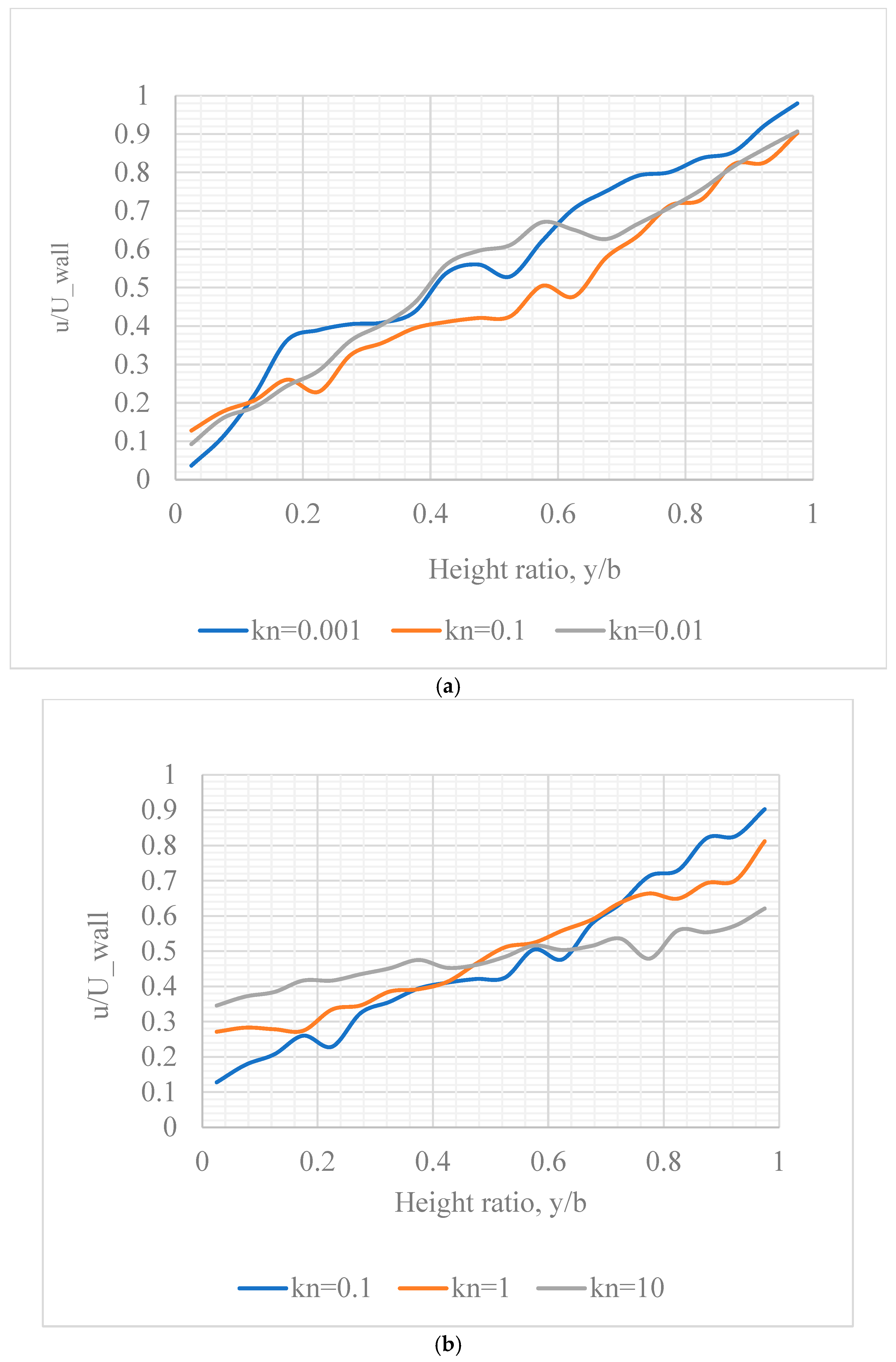

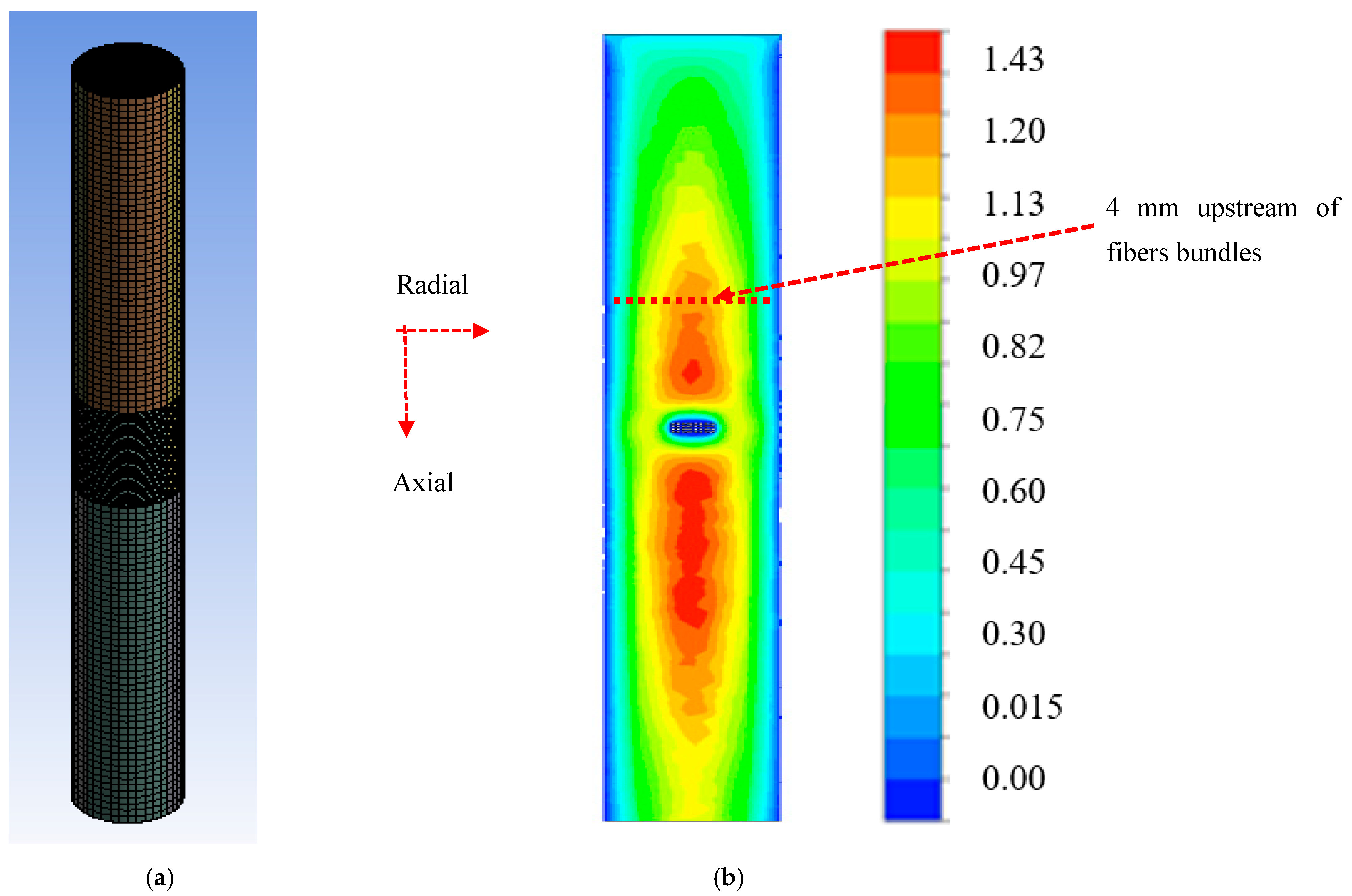

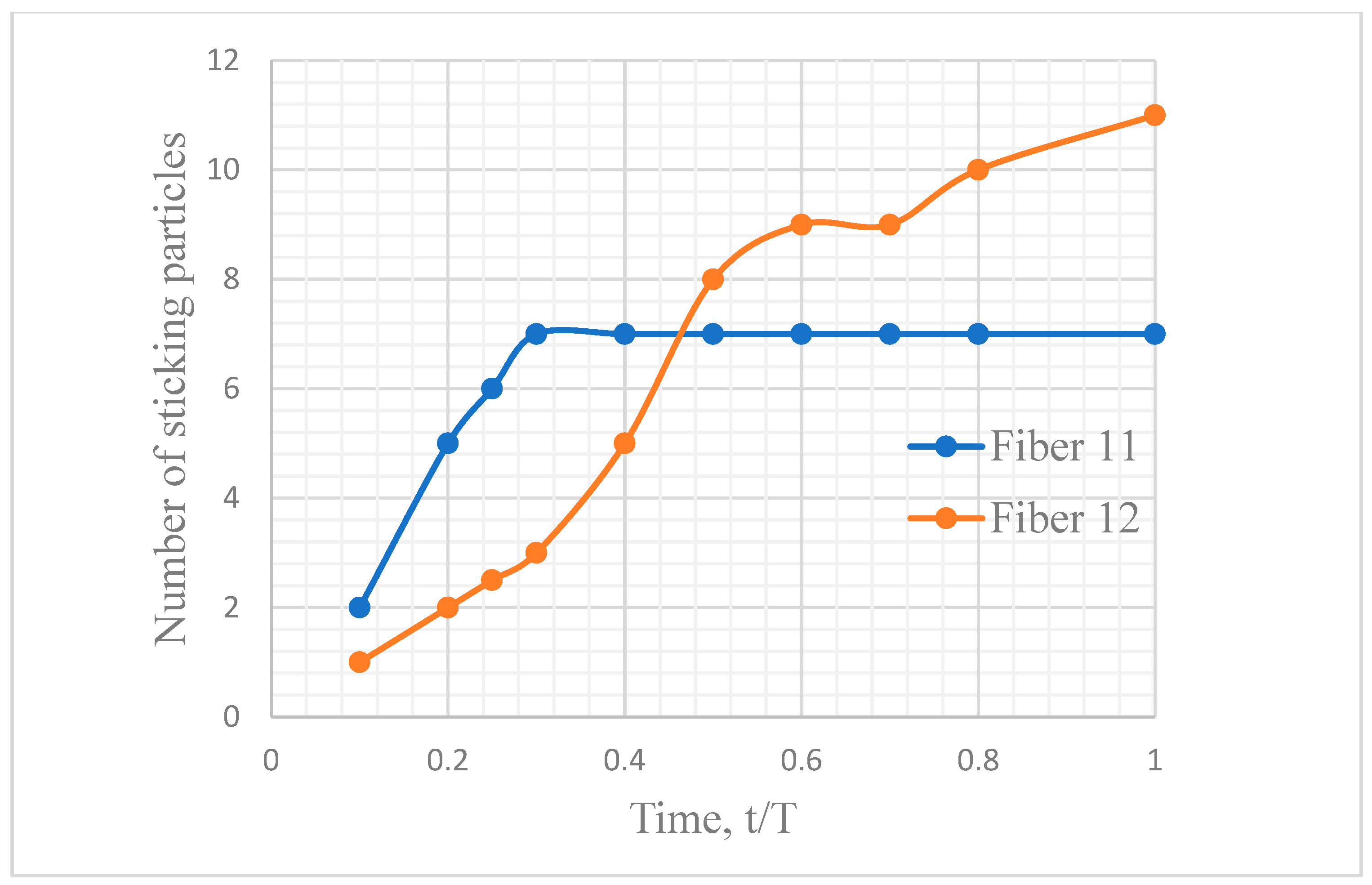
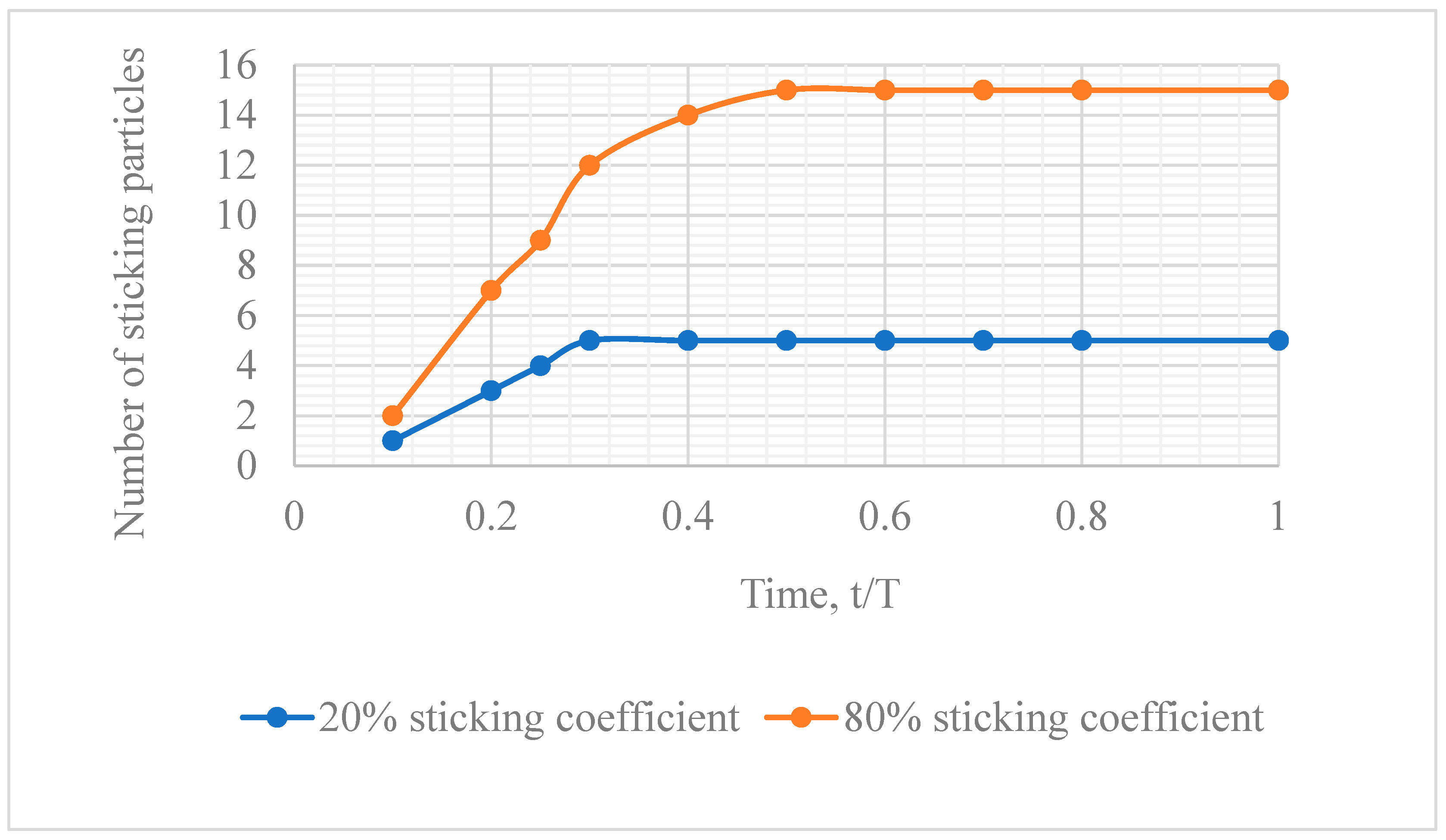
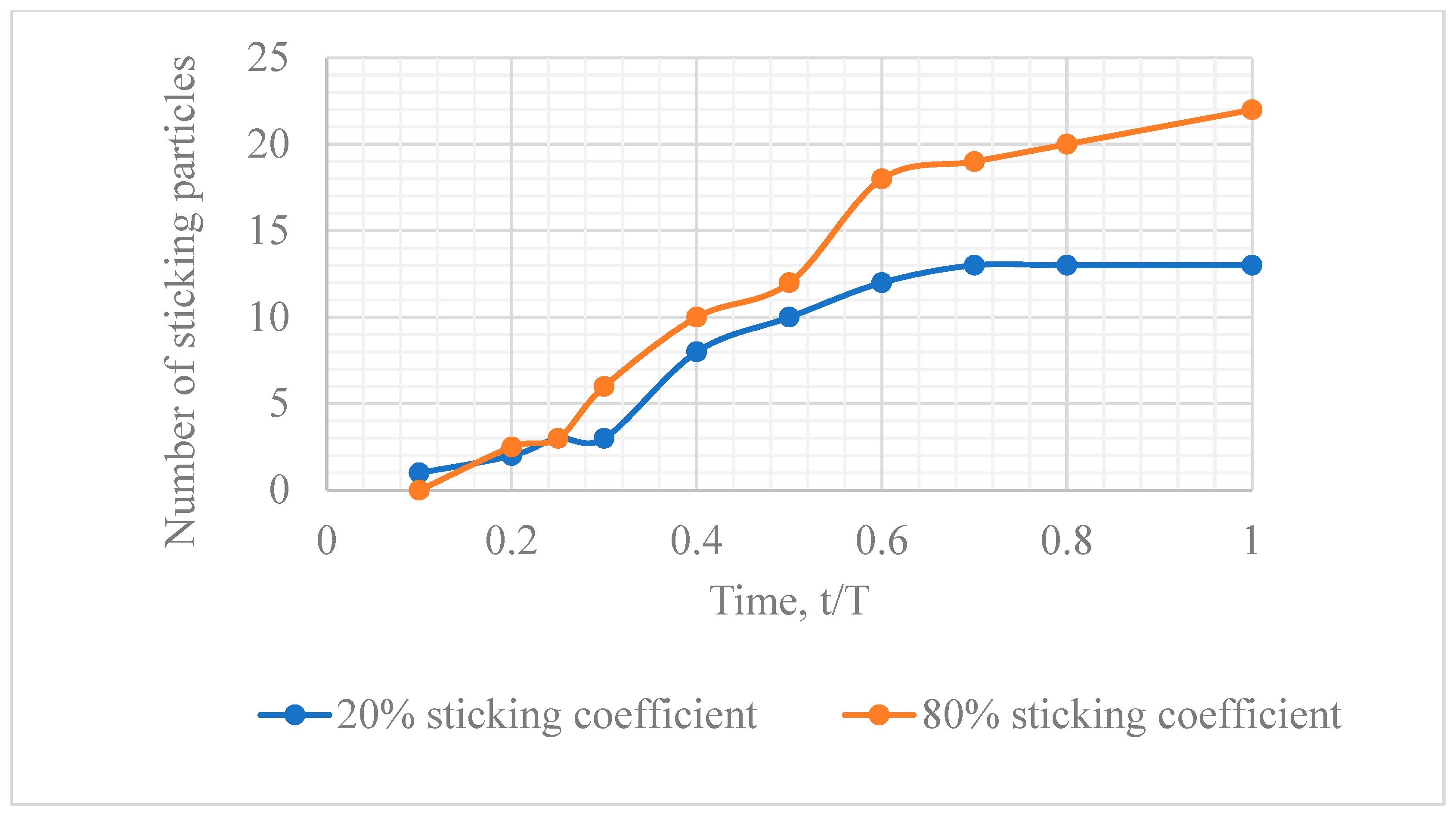

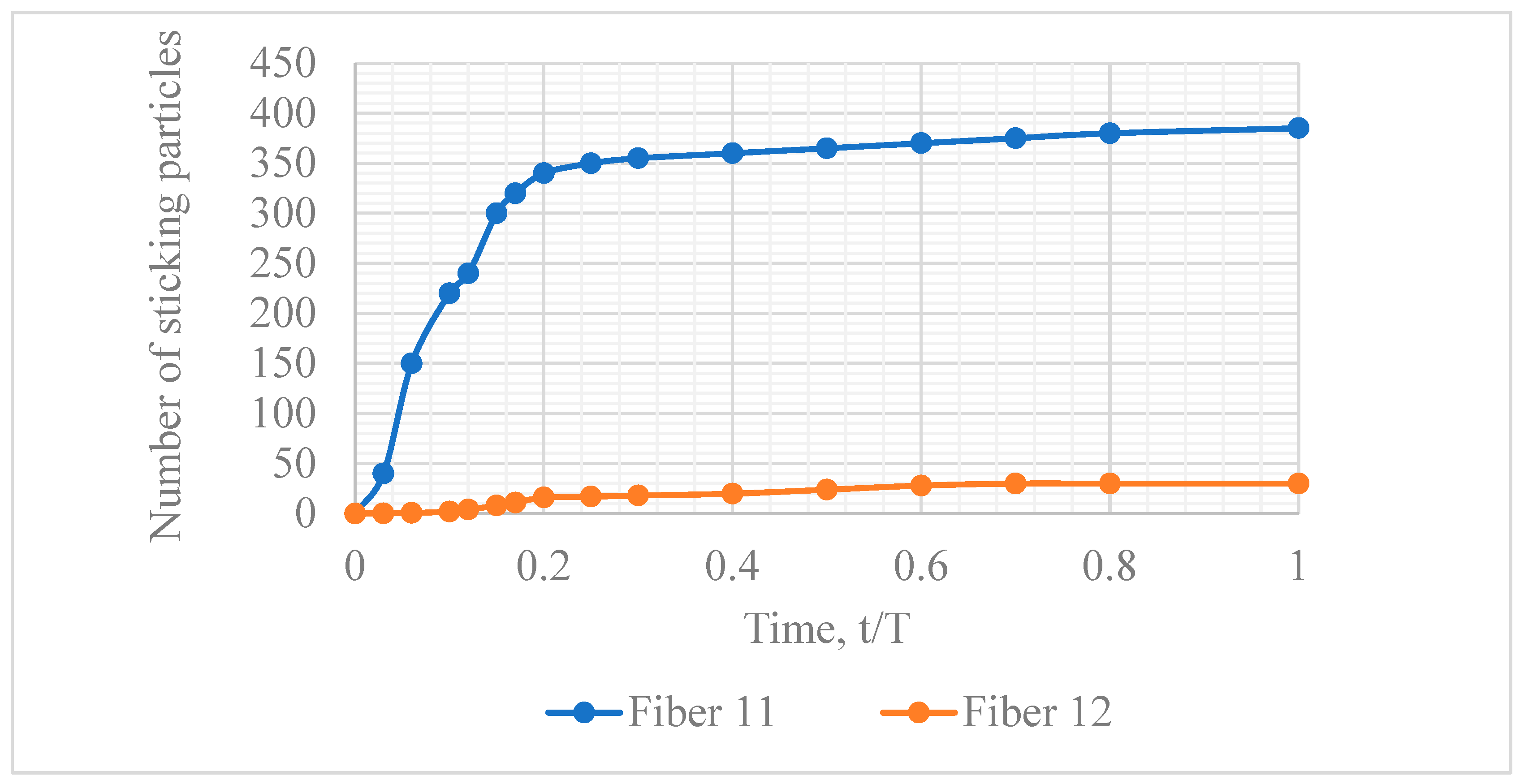
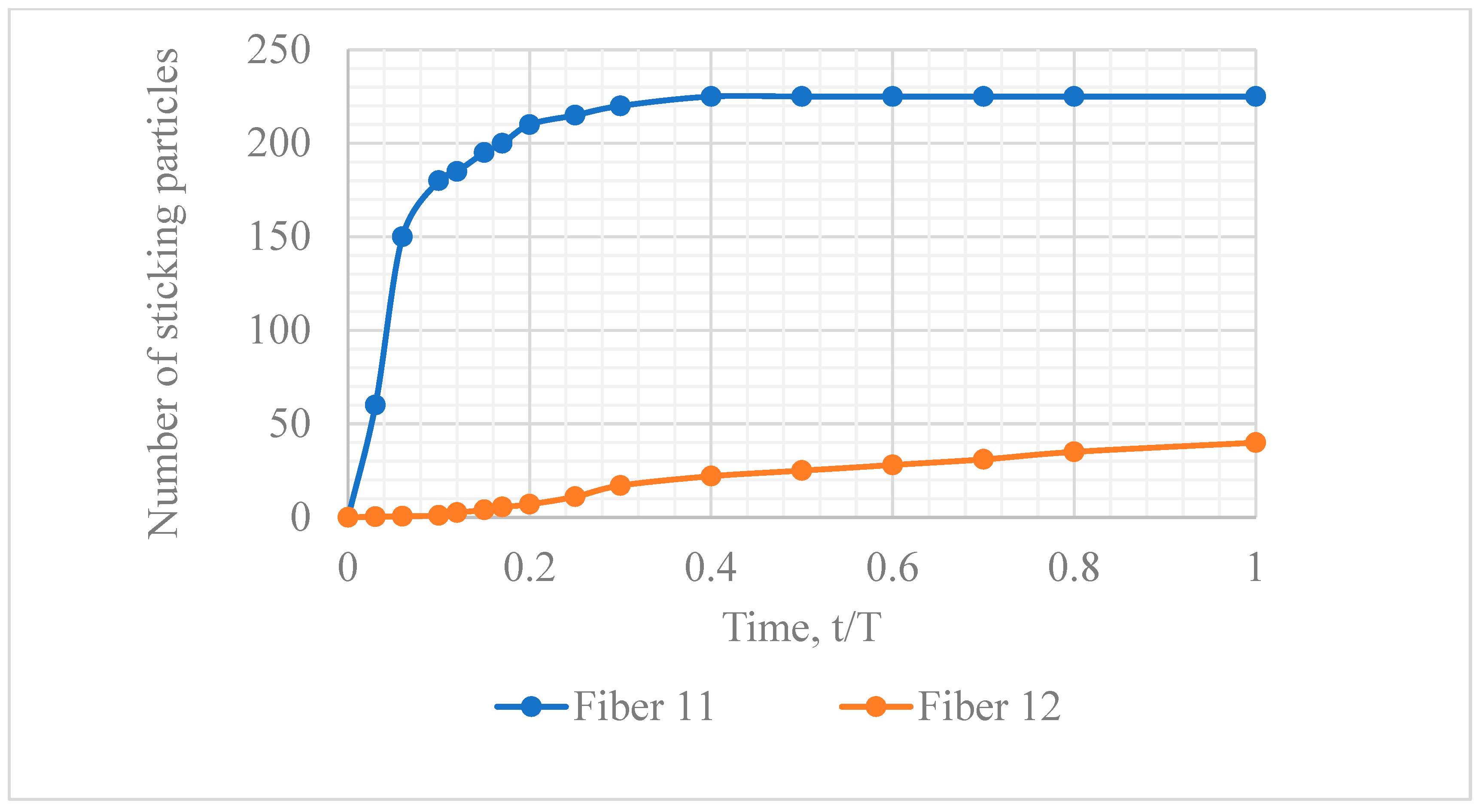
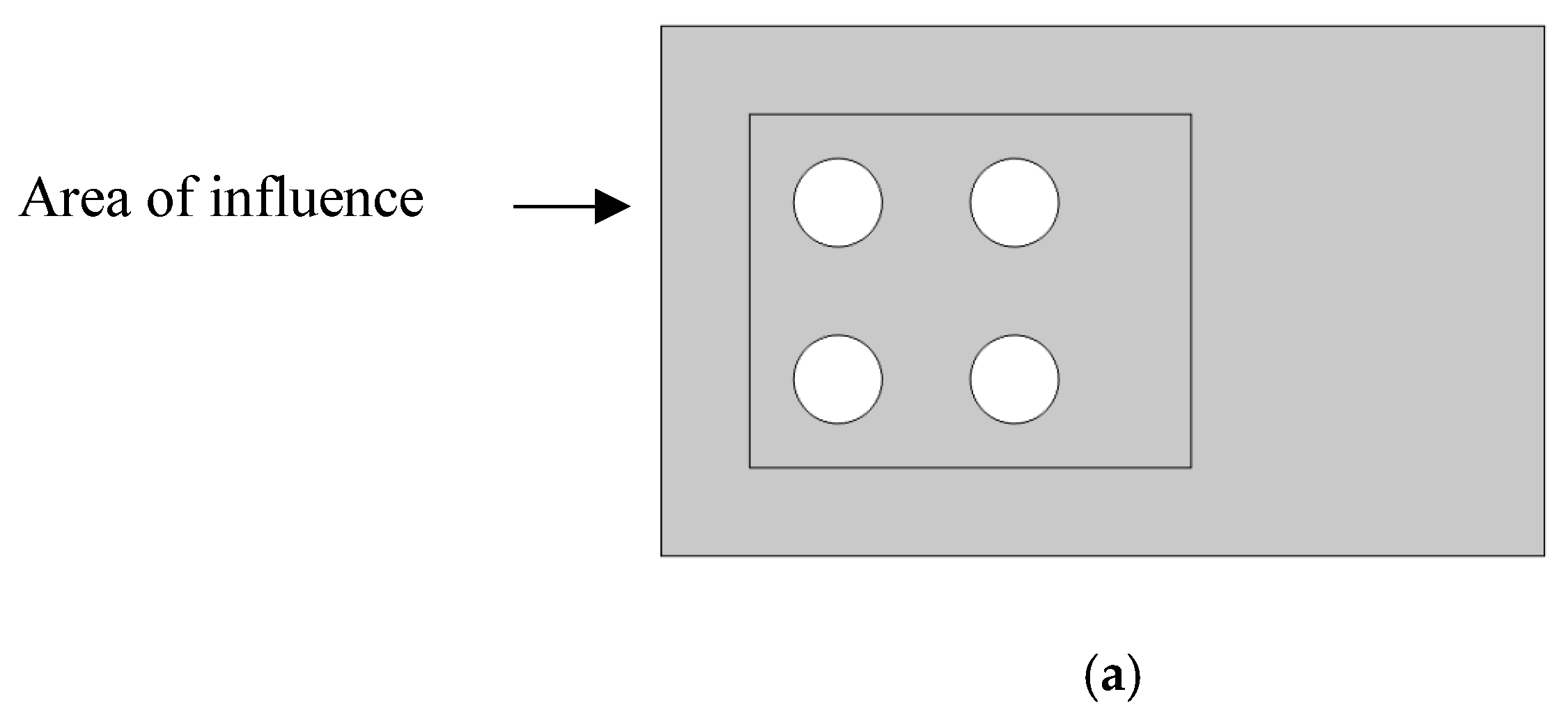



| Knudsen Number, Kn | Length (m) | Mean Free Path (m) | Pressure, Pa | Number Density, n |
|---|---|---|---|---|
| 0.001 | 1 × 10−6 | 1 × 10−9 | 4.89 × 106 | 1.19 × 1027 |
| 0.01 | 1 × 10−6 | 1 × 10−8 | 4.89 × 105 | 1.19 × 1026 |
| 0.1 | 1 × 10−6 | 1 × 10−7 | 4.89 × 104 | 1.19 × 1025 |
| 1 | 1 × 10−6 | 1 × 10−6 | 4.89 × 103 | 1.19 × 1024 |
| 10 | 1 × 10−6 | 1 × 10−5 | 4.89 × 102 | 1.19 × 1023 |
| Fiber | Number of Simulated Particles | Mass of Deposited Layer, Nanogram |
|---|---|---|
| Fiber 11 | ~7 | 290 |
| Fiber 12 | ~11 | 457 |
| Fiber 21 | ~7 | 290 |
| Fiber 22 | ~11 | 457 |
Disclaimer/Publisher’s Note: The statements, opinions and data contained in all publications are solely those of the individual author(s) and contributor(s) and not of MDPI and/or the editor(s). MDPI and/or the editor(s) disclaim responsibility for any injury to people or property resulting from any ideas, methods, instructions or products referred to in the content. |
© 2023 by the authors. Licensee MDPI, Basel, Switzerland. This article is an open access article distributed under the terms and conditions of the Creative Commons Attribution (CC BY) license (https://creativecommons.org/licenses/by/4.0/).
Share and Cite
Barua, H.; Povitsky, A. Continuum and Molecular Modeling of Chemical Vapor Deposition at Nano-Scale Fibrous Substrates. Math. Comput. Appl. 2023, 28, 112. https://doi.org/10.3390/mca28060112
Barua H, Povitsky A. Continuum and Molecular Modeling of Chemical Vapor Deposition at Nano-Scale Fibrous Substrates. Mathematical and Computational Applications. 2023; 28(6):112. https://doi.org/10.3390/mca28060112
Chicago/Turabian StyleBarua, Himel, and Alex Povitsky. 2023. "Continuum and Molecular Modeling of Chemical Vapor Deposition at Nano-Scale Fibrous Substrates" Mathematical and Computational Applications 28, no. 6: 112. https://doi.org/10.3390/mca28060112





